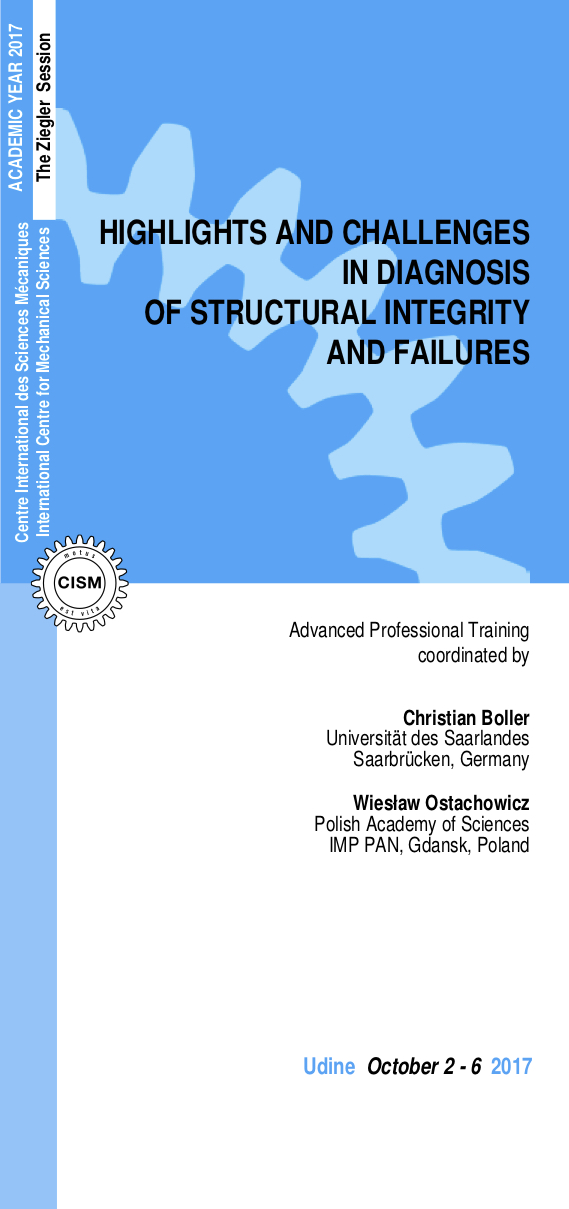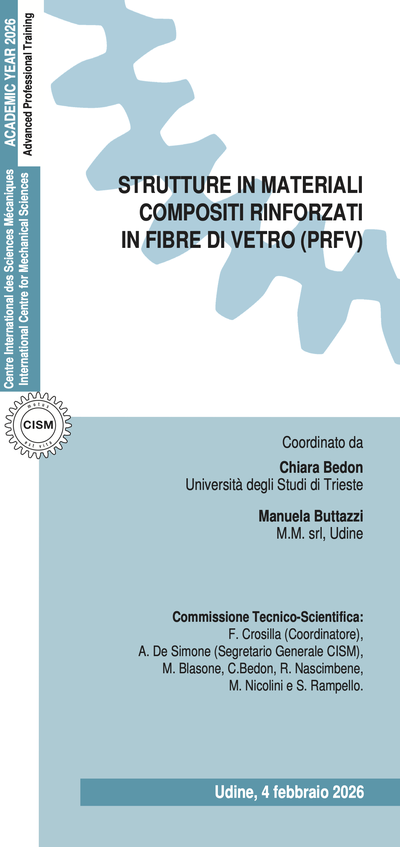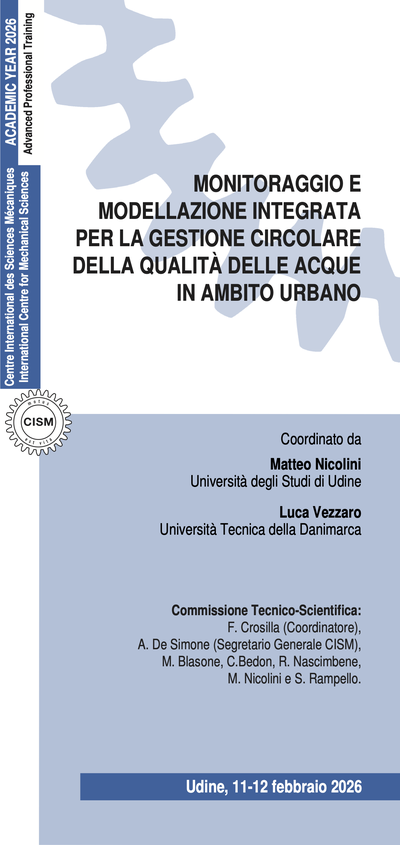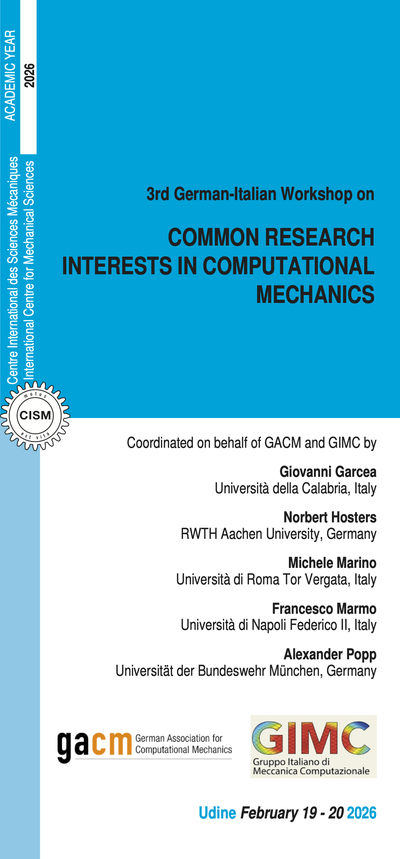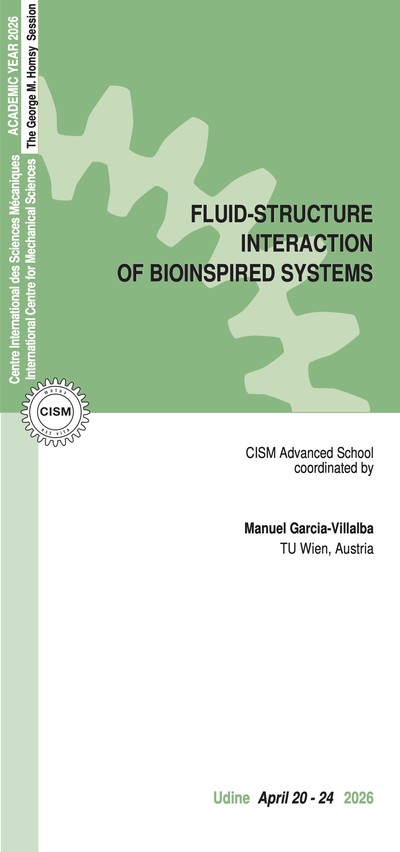The objective of this course is to prepare future experts to configure diagnosis systems for civil, offshore, aerospace and mechanical structures. To achieve this, so that the structures become lighter, damage is allowed to exist during operation as long as it is within safe, predetermined specifications. Course participants shall have the opportunity to learn about emerging technologies, dealing with the development and implementation of techniques and systems where automated monitoring, inspection and damage detection becomes an integral part of the structures. A major part of the lectures will be dedicated to composite materials increasingly used for ‘modern’ structures. Composite components are lightweight and have excellent fatigue and corrosion resistance. Failure of these structures is still less understood when compared to metals, and therefore it is still a matter of concern and specific attention. To cope with damage in those comparatively new materials, monitoring technologies and strategies are required in order to allow for the advantage of their light weight potential to be used on one hand, and not to compromise safety on the other. The aim of the course is therefore to describe and explain current research in areas of application and tendencies for the future of this technology including the various design issues. The theory and techniques that are important for understanding the topics covered will be addressed. Composite structures may be designed according to a damage tolerant philosophy, once the relevant technologies are available. Defects in those composite materials may arise during manufacture due to voids/ porosity, ply misalignment or inclusion of foreign microscopic particles that show no evidence to the naked eye. There is a list of examples of such defects: composite elements delaminated and/or contaminated by moisture (water, skydrol, etc.) or chemicals (silicon, etc.), thermal degradation and defects in composite bonds. Also surface contaminants of composite elements that appear during the manufacturing process are included in those examples. Damage mechanisms for such materials shall be thus covered, along with the latest developments in monitoring technologies. The objective of this lecture series is therefore also to get the basic knowledge from the field of smart structures that laterally encompasses disciplines such as structural dynamics, materials and structures, fatigue and fracture, non–destructive testing and evaluation, sensors and actuators, microelectronics, signal processing and many more. This also includes monitoring of external and internal loads with the goal of obtaining information about impacts or excessive fatigue loads in view of damage prognosis. A multidisciplinary approach among these disciplines is therefore required to holistically manage the operation of an engineering structure through its life cycle. The most commonly used methods are: active thermography, ultrasound including electro– mechanical impedance techniques, eddy current, terahertz technology (THz), and others including variations and combinations. The course is addressed to: students in post–graduate school (M.Sc. level); Ph.D. students; researchers interested in diagnosis of structural integrity and failures; practicing engineers interested in the field of health monitoring, maintenance, repair and overhaul.
Boller C., Chang F.-K., Fujino Y. (Eds): Encyclopedia of Structural Health Monitoring, Vol. 1, Part 1: Introduction and Definitions. John Wiley & Sons, 2009. ISBN 978-0-470-05822-0. Beine C., Boller C., Netzelmann U., et al., NDT for CFRP Aeronautical Components - A Comparative Study. [In]: DGZfP Int. Symp. NDT in Aerospace. Hamburg/Germany 2010, www.ndt.net Ostachowicz W., Güemes A., (eds.): New Trends in Structural Health Monitoring. Springer, 2013 (436 p.) ISBN 978-3-7091-1389-9. Ostachowicz W., Kudela P., et. al.: Guided Waves in Structures for SHM. The Time – Domain Spectral Element Method. John Wiley & Sons, 2012, ISBN 978-0-470-97983-9. Ginsberg D., Ruby M., Fritzen C.-P., Load identification approach based on basis pursuit denoising algorithm, J. of Physics, Conf. Series, 11th DAMAS, Vol. 628., 2015, http://iopscience. iop.org/article/10.1088/1742-6596/628/1/012030. Buethe I., Dominguez N., Jung H., Fritzen C.-P., Ségur D., Reverdy F., Path-based MAPOD using numerical simulations, [In]: Woelcken, P., Papadopoulos, M. (Eds.), Smart Intelligent Aircraft Structures (SARISTU) - Springer, 2016, pp. 631-642, http://www.springer.com /us/book/9783319224121. Fassois S.D., Sakellariou J.S., Statistical Time Series Methods for SHM. [In]: Encyclopedia of Structural Health Monitoring, Boller C., Chang F., Fujino, Y. (Eds.): John Wiley & Sons Ltd, Chichester, UK, pp. 443-472, 2009. Kopsaftopoulos F., Fassois S.D., Vibration based health monitoring for a lightweight truss structure: experimental assessment of several statistical time series methods. Mechanical Systems and Signal Processing, Vol. 24, pp. 1977-1997, 2010. Structural Monitoring with Fiber Optic Technology.[In]: New Trends in Structural Health Monitoring. Ostachowicz W., Güemes A. (Eds):Springer, 2013, ISBN 978-3-7091-1389-9. Glišic´ B., Inaudi D.: Fiber Optic Methods for Structural Health Monitoring. John Wiley & Sons Ltd., 2007. G. Mustafa G., Suleman A., Crawford C., Probabilistic micromechanical analysis of composite material stiffness properties for a wind turbine blade. J. Composite Structures, Vol. 131 (1), Nov. 2015, pp. 905-916. Kocaman E.S., Keulen C.J., Akay E., Yildiz M., Turkmen H.S., Suleman A., An experimental study on the effect of length and orientation of embedded FBG sensors on the signal properties under fatigue loading. Science and Engineering of Composite Materials, doi: 10.1515/secm-2014-0029, 2015. McGugan M., Pereira G. F., Sørensen B. F., Toftegaard H. L., Branner K., Damage tolerance and structural monitoring for wind turbine blades. [In]: Royal Society of London. Philosophical Transactions A. Mathematical, Physical and Engineering Sciences, 373, 16 p., 20140077, 2015. Ostachowicz W., McGugan M., Schröder-Hinrichs J.-U., Łuczak M.(Eds.), MARE-WINT - New Materials and Reliability in Offshore Wind Turbine Technology (2016) ISBN 978-3-319-39094-9, open access: http://www.springer.com/us /book/9783319390949.
Christian Boller (None)
Safe Life and Structural Load versus Damage Tolerance Structural Design Principles5 lectures on:The safe life versus damage tolerance structural design principle; structural load spectra assessment and characterisation; fatigue in composites – how to do the evaluation?; non–destructive testing techniques with a special emphasis on composites; structural health monitoring and its impact on life cycle management of structures.
Spilios D. Fassois (None)
Statistical Time Series Methods for the Diagnosis of Structural Integrity5 lectures on:Introduction to statistical methods for damage diagnosis under uncertainty, random signal fundamentals and analysis, non–parametric diagnosis methods, parametric diagnosis methods, applications and advanced topics.
Claus-Peter Fritzen (None)
Overview of Methods for Damage Detection in Diagnosis of Structural Integrity5 lectures on:Overview of methods for damage detection, vibration– and wave–based methods, model–based identification of unknown loads; sparse recovery techniques for impact identification for smart composite structures, electromechanical impedance method and sensor self–diagnosis, reliability and risk assessment concepts, probability of detection (POD).
Alfredo Gúemes (None)
Advanced Composite Materials – Typical Defects and In–Service Inspections5 lectures on: Overview of advanced composite materials; typical defects and in–service damage; conventional NDT inspections and protocols; emerging non–contacts techniques, like thermography and laser ultrasonics; strain mapping, damage detection from strain measurements; distributed sensing.
Malcolm McGugan (None)
Damage Tolerance and SHM for wind turbine rotor blades5 lectures on: Damage tolerance for wind turbine rotor blades; structural health monitoring for wind turbine rotor blades; simulation tool for embedded fibre Bragg gratings; holistic management of composite structures; guidelines for remaining lifetime calculations.
Wieslaw Ostachowicz (None)
Advanced Techniques in Diagnosis of Structural Integrity and Failures5 lectures on: Inspections of composite structures (moisture, thermal & chemical degradation, kissing bonds, delaminations); NDT/SHM methods for surface assessment and for structural joints; NDT/SHM methods for damage detection (laser vibrometry; terahertz spectroscopy; laser induced fluorescence; electromechanical impedance).
Afzal Suleman (None)
Modelling, Damage Monitoring and Life Prognosis of Advanced Composite Structures5 lectures on: Fatigue life prediction of laminated composites using a multiscale micromechanics based approach; probabilistic failure prediction of composite laminates; monitoring damage state of fiber reinforced composites; health monitoring of composite patch repairs using chirped FBG sensors.
The registration fee is 575.00 Euro + VAT taxes*, where applicable (bank charges are not included). The registration fee includes a complimentary bag, four fixed menu buffet lunches (on Friday upon request), hot beverages, downloadable lecture notes and wi-fi internet access. Applicants must apply at least one month before the beginning of the course. Application forms should be sent on-line through our web site: http://www.cism.it. A message of confirmation will be sent to accepted participants. If you need assistance for registration please contact our secretariat. Applicants may cancel their course registration and receive a full refund by notifying CISM Secretariat in writing (by email) no later than two weeks prior to the start of the course. If cancellation occurs less than two weeks prior to the start of the course, a Euro 50.00 handling fee will be charged. Incorrect payments are subject to Euro 50.00 handling fee. A limited number of participants from universities and research centres who are not supported by their own institutions can be offered board and/or lodging in a reasonably priced hotel or student dormitory, if available. Requests should be sent to CISM Secretariat byJuly 25, 2017 along with the applicant's curriculum and a letter of recommendation by the head of the department or a supervisor confirming that the institute cannot provide funding. Preference will be given to applicants from countries that sponsor CISM. Information about travel and accommodation is available on our web site, or can be mailed upon request.
* Italian VAT is 22%.
